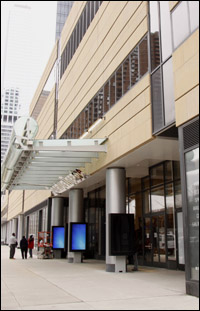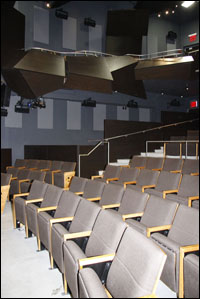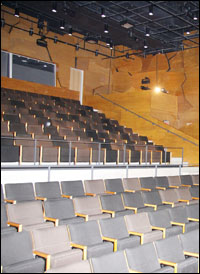
The door behind him opened into a large, airy rehearsal space. One hall led to one of the center's three theatre spaces; another hall led to a second theatre.
"This whole building is designed for orchestrated collisions," said Houghton, the founder and artistic director of the 20-year-old Signature Theatre Company, which began in a small storefront on Bond Street in lower Manhattan. "And this is one of the points of collision. These three companies will collide into each other and meet and talk. Designer David Gallo [who is working on the world premiere of Katori Hall's Hurt Village as part of Signature's Residency Five series of new plays] just wrote me an e-mail late last night saying, 'It works! I just ran into Chris Barreca who's designing Blood Knot. I had an experience with one of the actors in another company. I had a conversation with you and your family. And I made it for my paint call in my space!'"
| |
 |
|
| The new exterior |
Part of what makes this meeting of energies possible is that the building which the Signature occupies consumes an entire city block between Dyer Avenue and 10th Avenue in midtown. This allows, structurally, for all the theatre and rooms to be on the same floor. In a city like New York, where real estate is scant and precious, such a situation is nearly unheard of.
"Instead of stacking theatres, the real goal here was to create a true hub," said Houghton, standing beside a large wall portrait of late Pulitzer Prize-winning playwright August Wilson, one of many such paintings which adorn the white surfaces of the center. (Signature devoted an entire season to Wilson's work in the past; one-playwright-per-season was Signature's primary mission from the start. As of 2012, the mission has greatly expanded.) "It's a village green of sorts, where we can have a shared experience," Houghton said. "We're able to put all the theatres on one level and surround a very active lobby with a cafe and a bookstore and concierge area. You're literally a few yards away from all three theatres. You no longer have to bifurcate your audience. You're creating a dynamic community, sharing a theatre-going experience together. To my mind, it's a bit of a game-changer. We don't have that in the theatre."
| |
 |
|
| Inside The Alice Griffin Jewel Box Theatre | ||
| photo by Joseph Marzullo/WENN |
Gehry touches can be spotted throughout the space — the undulating canopy above the main entrance; the twisting railings along the balcony of the Griffin Theatre; the jigsaw of wooden panels on the sides of the End Stage; the herky-jerky spiral of the central staircase leading up from the entryway to the theatres. And yet the complex is a departure from the usual flashy, attention-getting style of "starchitect" Gehry. The modest building materials include plywood, glass and concrete. "These are very basic materials that are accessible to anyone," explained Houghton. "The difference is you take a great artist like Frank and he uses that material in an imaginative way." The theatre complex is only the third Gehry structure in New York City.
Signature's search for a new home has been a long one. Originally, shortly after 9/11, they were slated to be part of an arts complex set to go up near Ground Zero. At that time, Gehry was tapped to be the architect. "We spent four years with the city trying to figure out how to get it done," recalled Houghton. "Ultimately, the mayor asked us to look across the street because the cost was so high for the building. We were on probably the most expensive site in the world to build. It had seven stories below it, two trains, a mall, a parking garage, security system" — all of which made the location very costly to build upon.
But the suggested space didn't work either. The City worked with Signature to find a new location. The search led to Related Companies, which was building a mixed-use apartment complex on West 42nd Street. Due to a "theatre bonus" worked into the property back in the 1970s, "any development on this block and the block adjacent to it must have a dedicated amount of space for theatre," explained Houghton.
| |
 |
|
| Inside The End Stage Theatre | ||
| photo by Joseph Marzullo/WENN |
"Pop has helped us create a whole system to communicate what is going on inside the theatre in a very deep way," told Houghton. "These are the largest touch screens I know of. You'll see the history of the company come alive here. You can listen to videos, hear the writers talk about their work. As we do new work, it will be added. You can come in and learn about Blood Knot," the Athol Fugard play which began previews at the center on Jan. 31. (Fugard is the season's Residency One series playwright, as the core mission is now called.)
The panel in the middle has a social media aspect. Viewers are asked questions, such as why they go to the theatre, etc. Based on their responses, they're assigned a color. You can then take a picture of yourself, and the picture goes on the screen. "You memorialize your participation. You begin to see the audience, their dynamic," enthused Houghton.
As with everything about the complex, community is foremost in Houghton's mind when he considers the screens. Because they are so large, "the guy across the lobby having a drink or reading a book can see what you're looking at. The experiences begin to stack up."
Houghton also hopes to host young companies in the space, just as the Public Theater once housed Signature for a couple seasons. And the Signature offices contain rooms that the company's resident playwrights can use at any time. It all adds to the modern-day, theatrical agora that Houghton hopes the center will become.
"Edward Albee's going to be sitting there having a meeting with director David Esbjornson," said Houghton, pointing to one set of table and chairs in the lobby. Albee's The Lady From Dubuque will be the inaugural production at the End Stage, as part of the Signature Legacy Program devoted to plays by Signature alumni playwrights. "Any one of the actors or collaborators can be there at any given time. We're trying to see this as a dynamic cultural destination point."











